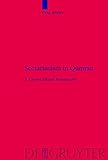Sectarianism in Qumran : a cross-cultural perspective / Eyal Regev.
Material type: TextSeries: Religion and society (Hague, Netherlands) ; 45.Publication details: Berlin ; New York : Walter de Gruyter, ©2007.Description: 1 online resource (xviii, 438 pages)Content type:
TextSeries: Religion and society (Hague, Netherlands) ; 45.Publication details: Berlin ; New York : Walter de Gruyter, ©2007.Description: 1 online resource (xviii, 438 pages)Content type: - 9783110896640
- 3110896648
- 3110193329
- 9783110193329
- Dead Sea scrolls
- Dead Sea scrolls
- Judaism -- History -- Post-exilic period, 586 B.C.-210 A.D
- Jewish sects
- Christian sects
- Qumran community
- Judaïsme -- Histoire -- 586 av. J.-C.-210 (Période postexilique)
- Sectes juives
- Sectes chrétiennes
- Communauté de Qumrān
- Christian sects
- RELIGION -- Judaism -- General
- Christian sects
- Jewish sects
- Judaism -- Post-exilic period (Judaism)
- Qumran community
- 586 B.C.-210 A.D
- 296.8/15 22
- BM176 .R44 2007eb
- online - EBSCO
- BC 8920
| Item type | Current library | Call number | URL | Status | Notes | Barcode | |
|---|---|---|---|---|---|---|---|
 eBook
eBook
|
Biblioteca "Angelicum" Pont. Univ. S.Tommaso d'Aquino Nuvola online | online - EBSCO (Browse shelf(Opens below)) | Online access | Not for loan (Accesso limitato) | Accesso per gli utenti autorizzati / Access for authorized users | (ebsco)558213 |
Browsing Biblioteca "Angelicum" Pont. Univ. S.Tommaso d'Aquino shelves, Shelving location: Nuvola online Close shelf browser (Hides shelf browser)

|

|

|

|

|

|

|
||
| online - EBSCO Second Temple Jewish 'Paideia' in context / | online - EBSCO Second Temple Pseudepigraphy : a Cross-cultural Comparison of Apocalyptic Texts and Related Jewish Literature. | online - EBSCO Secret habits : Catholic literacy education for women in the early nineteenth century / | online - EBSCO Sectarianism in Qumran : a cross-cultural perspective / | online - EBSCO Sects and sectarianism in Jewish history / | online - EBSCO Sects, cults, and spiritual communities : a sociological analysis / | online - EBSCO Secular faith / |
Includes bibliographical references (pages 391-425) and index.
Pages:1 to 25; Pages:26 to 50; Pages:51 to 75; Pages:76 to 100; Pages:101 to 125; Pages:126 to 150; Pages:151 to 175; Pages:176 to 200; Pages:201 to 225; Pages:226 to 250; Pages:251 to 275; Pages:276 to 300; Pages:301 to 325; Pages:326 to 350; Pages:351 to 375; Pages:376 to 400; Pages:401 to 425; Pages:426 to 450; Pages:451 to 456.
Sectarianism in Qumran: A Cross-Cultural Perspective explores the sectarian characteristics of the system of beliefs and laws of the two major Qumran sects of the Dead Sea Scrolls, the yahad and the Damascus Covenant, using theories of sectarianism and related topics in sociology, anthropology and the study of religion. It discusses Qumranic moral and purity boundaries, cultic rituals, wealth, gender, atonement, revelation mysticism, structure and organization and compares them with those of seven sects of the same (introversionist) type: the early Anabaptists, Mennonites, Hutterites and Amish, Puritans, Quakers and Shakers. The sociological and historical relationship between the Qumran sects and the related movements of 1 Enoch, Jubilees and the Essenes are analyzed in detail, in order to understand the socio-religious background of sectarianism in Qumran and its subsequent variations. Throughout the chapters, differences between the yahad, the Damascus Covenant and the Essenes are observed in relation to social boundaries, social structure, gender relations, revelation and inclination towards mysticism. Points of resemblance and difference are traced between the Qumran sects and the early-modern Christian ones, and several different patterns of sectarian ideology and behaviour are noticed among all these sects.


